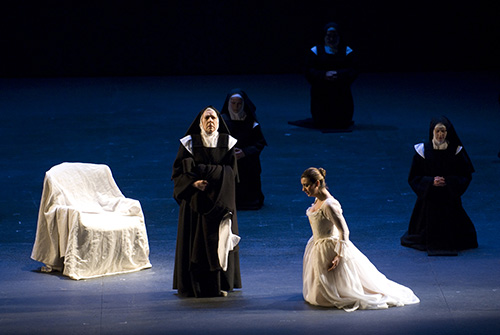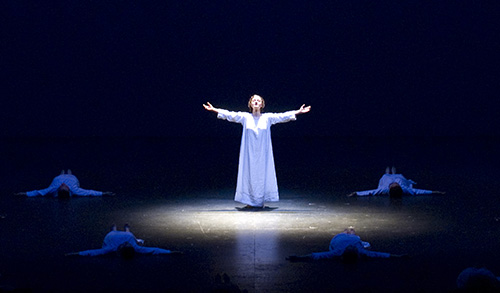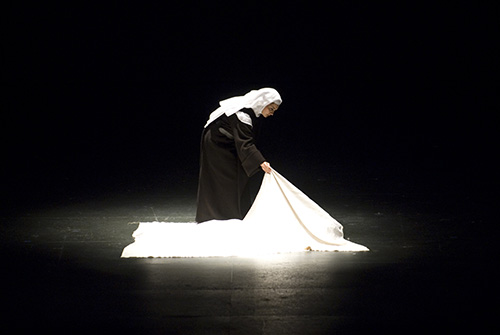-
Introduction to Dialogues des Carmélites
By Danielle D'OrnellasPosted in 2012/2013
Dialogues des Carmélites
What's it all about?
In 1794, sixteen members of the members of the Carmel of Compiègne (also known as the Martyrs of Compiègne) were felled by the guillotine as the Reign of Terror swept through post-revolutionary France. The women refused to put away their habits and paid with their lives, but despite their death sentence, their faith prevailed. The women were remembered for renewing their vows and singing as they approached the scaffold.
137 years later, Gertrud von Le Fort released a novella titled Die Letzte am Schafott ("The Last on the Scaffold") and two decades later, Francis Poulenc's opera about the doomed order debuted. The book and subsequently the opera was based on a surviving nun's recollection of the events, told through the perspective of a fictional heroine which she based on herself. The character? The timid and uncertain noblewoman, Blanche de la Force.
Not the strongest of characters at the outset, Blanche is a meek woman who is terrified by the uprising of the French revolutionaries. After one particularly frightening swarming by a local mob, she announces to her family that she wants to become a nun in order to escape the harsh world outside. But with the Reign of Terror spreading across the French countryside, the struggles Blanche will eventually face in the abbey come to test her strength, character and faith in ways that the outside world never could. When the executioners come to call, on which side of the scaffold will she fall?
Why is it special?
Easily considered Poulenc's greatest work, the Dialogues des Carmélites came out during a time when composers were experimenting with musical styles that deviated, if not outright abandoned traditional Western harmonic and melodic principles. But Poulenc's composition and his adherence to tonality allied him with the composers of the past, the greats like Debussy, Mussorgsky, Monteverdi, and Verdi.

THE PRODUCTION
What will it look like?
After his wildly successful Dora Award-winning productions of Iphigenia in Tauris (2011/2012) and Orfeo ed Euridice (2010/2011), Robert Carsen returns to the COC with Dialogues des Carmélites. Originally created for Nederlandse Opera in 1997, Carsen’s acclaimed production has been presented to great acclaim at some of the world’s great opera houses, such as La Scala and Lyric Opera of Chicago. The production features Carsen’s signature streamlined approach – a minimalist, uncluttered set, combined with strong lighting design and the use of over 100 supernumeraries (onstage extras) to highlight the overwhelming anxiety felt during the French Revolution’s Reign of Terror. Set designer Michael Levine last worked with the COC for 2011's Rigoletto, the lighting design is by Jean Kalman and the costume design by Falk Bauer. Choreography for Dialogues des Carmélites is by Philippe Giraudeau who was last with the COC for 2011’s Iphigenia in Tauris.
Who is starring in it?
COC Ensemble Studio graduate and Grammy Award nominee Isabel Bayrakdarian returns to the COC as the conflicted Blanche de la Force. The last time she appeared on stage at the Four Seasons Centre was in 2011 as Euridice in Orfeo ed Euridice.
Legendary mezzo-soprano Judith Forst has performed with the Canadian Opera Company for over four decades, and returns to sing in Dialogues des Carmélites as the tough, no-nonsense Madame de Croissy. Judith Forst last performed at the COC for The Queen of Spades in 2002.
Internationally renowned soprano Adrianne Pieczonka returns to the Four Seasons Centre after her highly lauded performance in Tosca in 2012. In Dialogues des Carmélites, Pieczonka will make her role debut as the strong, faithful and resilient Madame Lidoine.
Canadian soprano Hélène Guilmette, a rising star from Quebec, makes her COC debut as Sister Constance. Russian mezzo-soprano and Metropolitan Opera regular Irina Mishura, who last performed in the COC's 2009 production of Rusalka, returns to the COC in the role of Mother Marie. Canadian mezzo-soprano Megan Latham, last seen in our 2011 Rigoletto, returns to the COC to perform as Mother Jeanne, and COC Ensemble Studio mezzo-soprano Rihab Chaieb, last seen in the Ensemble Studio production of La clemenza di Tito, rounds out the order of Carmelite nuns as Sister Mathilde.
Canadian baritone Jean-François Lapointe last performed with the COC in 2000 as Pelléas in Pelléas et Mélisande and makes a long-awaited return to the COC as Blanche’s father, the Marquis de la Force. Canadian tenor Frédéric Antoun, last with COC as Tamino in the 2011 production of The Magic Flute is the Chevalier de la Force, Blanche's brother.
Other performers include Doug MacNaughton as Thierry, the footman, and Monsieur Javelinot, the doctor; tenor Michael Colvin as the Chaplain; COC Ensemble Studio tenor Christopher Enns as the First Commissioner; and baritone Peter Barrett is the Jailer. American bass-baritone Evan Boyer is the Second Commissioner, Ensemble Studio baritone Cameron McPhail is an Officer and Ensemble Studio soprano Claire de Sévigné is Une Voix.

THE HISTORY
Who is Poulenc?
Francis Poulenc was born at the turn of the century, to a musically gifted mother who provided him with a musical education as a child and then introduced him to Spanish pianist Ricardo Vines. Poulenc started composing works in his late teens and his early work Rapsodie Nègre caught the eye of composer Igor Stravinsky. In the 1920s, Poulenc became involved with a group of artists called Les Six. While he initially composed primarily orchestral works, it was the rediscovery of his Catholic faith that brought a more spiritual tone to his work. With this new spiritual framework he coaxed his musical language into a melding of the sombre and the sensual, leading him to write three operas over the span of his career, Les mamelles de Tirésias (1939), Dialogues des Carmélites (1953-56), and La voix humaine (1959).
Learn more about Francis Poulenc here.
When did it premiere?
The opera premiered at La Scala on the Jan. 26, 1957, sung in Italian. The French-language version, with some additional orchestral interludes added, was first performed a few months later at the Paris Théâtre national de l’Opéra. Many productions of the work quickly followed upon its premiere, including the Covent Garden premiere the following year as well as a televised production.
Learn more about the historical background here.
LISTENING GUIDE
What are the most memorable musical moments?
Mes filles, j'ai désiré de tout mon coeur vous sauver - After the nuns are sentenced to death as counter-revolutionaries, the new Prioress, Madame Lidoine, gives the nuns her blessing in this haunting aria.
Salve Regina - The nuns, led by Madame Lidoine, bravely make their way to the scaffold. The powerful unity of their voices slowly dwindles as one by one they are killed and only Sister Constance's voice remains.Visit COC Radio to browse all of our listening guides.
Photos: Felicity Palmer as Madame de Croissy and Isabel Bayrakdarian as Blanche de la Force in a scene from Dialogues des Carmélites; (middle) Isabel Bayrakdarian as Blanche de la Force in a scene from Dialogues des Carmélites; (bottom) Isabel Bayrakdarian as Blanche de la Force in a scene from Lyric Opera of Chicago's production of Dialogues des Carmélites, 2007. Photos by Robert Kusel
